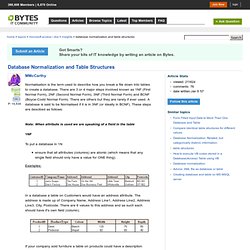

Common Queries Tree. Common MySQL Queries Basic aggregation Last updated 01 Oct 2016 Aggregate across columns Last updated 09 Sep 2009 Aggregates across multiple joins Given a parent table and two child tables, a query which sums values in both child tables, grouping on a parent table column, returns sums that are exactly twice as large as they should be. CREATE TABLE packageCredit ( packageCreditID INT, packageCreditItemID INT, Last updated 22 Feb 2013 Aggregates excluding leaders You have a table of grouped ranks ...
Last updated 22 May 2009 Aggregates of specified size Find the values of a table column c1 for which there are a specified number of listed values in another column c2. All X for which all Y are Z You have an election database with tables for candidates, parties and districts. CREATE TABLE districts ( district char(10) DEFAULT NULL ) ENGINE=MyISAM DEFAULT CHARSET=latin1; INSERT INTO districts VALUES ('Essex'),('Malton'),('Riverdale'),('Guelph'),('Halton'); Last updated 19 Mar 2016 Cascading aggregates or. Data Mining and Analytic Technologies (Kurt Thearling) Database Normalization and Table structures. Unfortunately, this is not quite correct.

To give a quick summary, the normal forms are as follows: 1NF: Every row must be an identifiable relation. This means that, in a table, no row may be an exact duplicate of another row, and nor may the row be completely filled with NULL. 2NF All non-key attributes of the table must depend on the entire key. This means that, when a table has a compound key, attributes which depend only on a subset of the key columns should be moved out of the table.
Mapping Objects to Relational Databases: O/R Mapping In Detail. Most modern business application development projects use object technology such as Java or C# to build the application software and relational databases to store the data.

This isn’t to say that you don’t have other options, there are many applications built with procedural languages such as COBOL and many systems will use object databases or XML databases to store data. However, because object and relational technologies are by far the norm that’s what I assume you’re working with in this article. If you’re working with different storage technologies then many of the concepts are still applicable, albeit with modification (don’t worry, Realistic XML overviews mapping issues pertaining to objects and XML). Table of Contents 1. When learning how to map objects to relational databases the place to start is with the data attributes of a class. It can make it easier to think that classes map to tables, and in a way they do, but not always directly.
For now, let’s keep things simple. 2. 3.